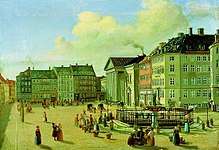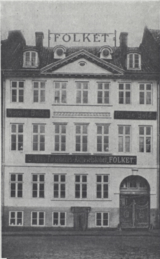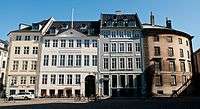Krak House
The Krak House (Danish: Kraks Hus) is a Neoclassical property overlooking the square Nytorv (No. 17) in the Old Town of in Copenhagen, Denmark. It takes its name after the publishing house Kraks Forlag which was based there for many years. The Danish Centre for Culture and Development, a self-governing institution under the Danish Ministry of Foreign Affairs, is based in the building.
| Krak House | |
|---|---|
Kraks Hus | |
_01.jpg) | |

| |
| General information | |
| Architectural style | Neoclassical |
| Location | Copenhagen, Denmark |
| Coordinates | 55°40′37.7″N 12°34′24.73″E |
| Current tenants | Danish Centre for Cilture and Development. |
| Completed | 1796 |
| Owner | Nordea |
History

The house was built for the merchant Hans Jessen in 1795-1796 after his previous property at the site had been destroyed in the Copenhagen Fire of 1795.[1]
The historian E. C. Werlauff lived in the building from 1823 to 1825. He was employed at the Royal Danish Library from 1798 and worked there for the next 65 years, replacing D. G. Moldenhawer as Chief Librarian in 1823. The writer and poet Henrik Hertz lived in the building from 1836 to 1837. Poul Martin Møller, writer and professor of philosophy at the University of Copenhagen, was a resident in the building from 1837 and until his death just over one year later.


The insurance company Assuranceselskabet Folket was based in the building at the turn of the century. The building was listed on the Danish Registry of Protected buildings and Places in 1918. It was purchased by the publishing house Kraks Forlag in 1920 and used as its new head office.[2] The company restored the building in 1986-1988 with the assistance of the architect Søren Cock-Clausen. In 1998. Kraks Forlag moved to a new headquarters in Virum north of Copenhagen. The associated foundation, Kraks Fond, moved to Ved Stranden 16 and is now based in Fæstningens Materialgård.
Architecture

The house consists of three storeys and a cellar. The seven-bay facade is tipped by a triangular pediment over the three central bays.
Today
The Danish Centre for Culture and Development, a self-governing institution under the Danish Ministry of Foreign Affairs, is based in the building. Other tenants include Fable Media and hydralab.[3]
References
- "Nytorv 7". indenforvoldene.dk (in Danish). Archived from the original on 14 November 2016. Retrieved 27 October 2016.
- "Nytorv 7". Kraks Fond (in Danish). Retrieved 27 October 2016.
- "Nytorv 7". 118.dk (in Danish). Retrieved 27 October 2016.